
Berwickshire is a historic county, registration county and lieutenancy area in south-eastern Scotland, on the English border. Berwickshire County Council existed from 1890 until 1975, when the area became part of the Borders region, with most of the historic county becoming part of the lower-tier Berwickshire district. Berwickshire district was abolished in 1996, when all the districts in the Borders region merged to become the Scottish Borders council area.
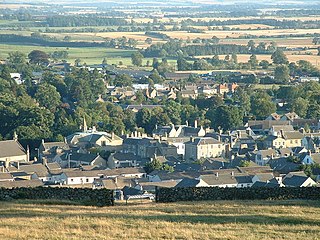
Duns is a town in the Scottish Borders, Scotland. It was the county town of the historic county of Berwickshire.

Peeblesshire, the County of Peebles or Tweeddale is a historic county of Scotland. Its county town is Peebles, and it borders Midlothian to the north, Selkirkshire to the east, Dumfriesshire to the south, and Lanarkshire to the west.

Roxburghshire or the County of Roxburgh is a historic county and registration county in the Southern Uplands of Scotland. It borders Dumfriesshire to the west, Selkirkshire and Midlothian to the north-west, and Berwickshire to the north. To the south-west it borders Cumberland and to the south-east Northumberland, both in England.

Greenlaw is a town and civil parish situated in the foothills of the Lammermuir Hills on Blackadder Water at the junction of the A697 and the A6105 in the Scottish Borders area of Scotland. At the 2001 census, the parish had a population of 661.

Duns Castle, Duns, Berwickshire is a historic house in Scotland, the oldest part of which, the massive Norman Keep or Pele Tower, supposedly dates from 1320. The castle and most of the structures on the property are designated as a scheduled ancient monument.

Marchmont Estate lies near the village of Greenlaw in Berwickshire in the Scottish Borders area of Scotland, circa 45 miles (72 km) south east of Edinburgh. It is situated in the Merse, an area between the Lammermuirs to the north and the Cheviots to the south. It is part of what is commonly regarded as an exceptionally beautiful landscape, comprising a diverse range of land types from high and exposed grouse moor to rich alluvial agricultural land. The life of the estate has seen many stages, including rapid growth, shrinkage and stability, from its foundation in the fifteenth century under the first Hume owner, Patrick Hume, of Polwarth, through his successors and subsequent owners to the present day.
The Duns Branch and the Berwickshire Railway together formed a through railway route from Reston, near Berwick-upon-Tweed, to St Boswells in the Scottish Borders. The line was promoted in two stages. The first was from Reston on the Edinburgh to Berwick main line to Duns ; it opened by the North British Railway in 1849.
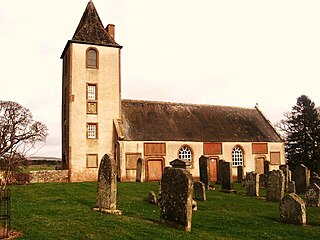
Polwarth Parish Church was a member church of the Church of Scotland before closing in 2004. It is situated atop a mound off a minor road leading from the A6105, Greenlaw to Duns road in the old county of Berwickshire, now privately owned by the Letts family who live in the adjacent Polwarth Manse and is available for weddings. It lies 4.0 miles (6.4 km) south–west of Duns and 3.5 miles (5.6 km) east of Greenlaw at grid reference NT749494.
Fogo is a village in the county of Berwickshire, in the Borders of Scotland, 3 miles south of Duns, on the Blackadder Water.
John Cunningham was a Scottish architect. He designed Lime Street railway station and the original Philharmonic Hall in Liverpool.

Renfrew Town Hall is a municipal facility at The Cross, Renfrew, Renfrewshire, Scotland. The town hall, which was the headquarters of the royal burgh of Renfrew, is a Category A listed building.

Rothesay Town Hall and County Buildings is a former municipal building in Castle Street, Rothesay, Scotland. The structure, which was the meeting place of Rothesay Burgh Council and of Bute County Council, is a Category B listed building.
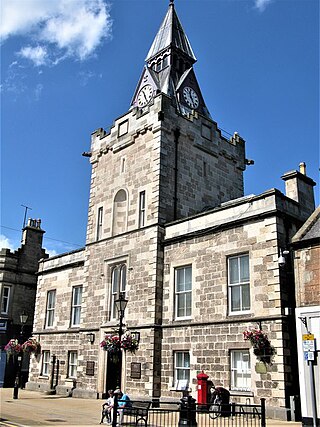
Nairn Town and County Buildings is a municipal structure in the High Street, Nairn, Highland, Scotland. The structure, which is used as a service point for The Highland Council, is a Category B listed building.
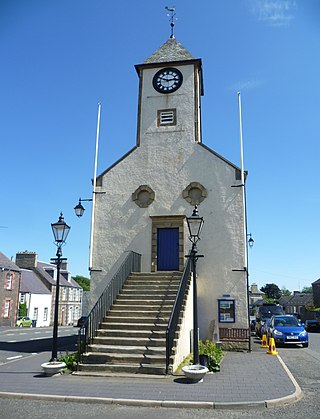
Lauder Town Hall is a municipal structure in the Market Place in Lauder, Scottish Borders, Scotland. The structure, which is used as the local registrar's office and as a venue for weddings and civil partnership ceremonies, is a Category B listed building.

Coldstream Town Hall is a municipal building in the High Street, Coldstream, Scottish Borders, Scotland. The structure, which currently accommodates a library and a registration office, is a Category B listed building.

County Buildings is a municipal building in Kirkcudbright, in the Dumfries and Galloway council area in Scotland. It was originally two houses on High Street, which then served as the main offices of Kirkcudbrightshire County Council from 1925 to 1975. A large extension to the rear was added in 1952, accessed from Daar Road. From 1975 until 1996 the building served as the offices of Stewartry District Council. Since 1996, it has been an area office of Dumfries and Galloway Council. It is a Category B listed building. Prior to the 1952 extension the name "County Buildings" was used for a different building, at 85 High Street, which was also the town's sheriff court.
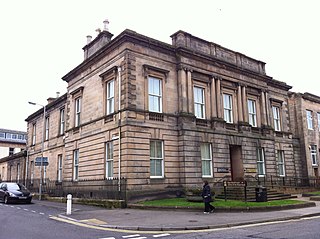
Elgin Sheriff Court is a municipal structure in the High Street, Elgin, Moray, Scotland. The structure, which was the headquarters of Morayshire County Council and remains in use as a courthouse, is a Category B listed building.
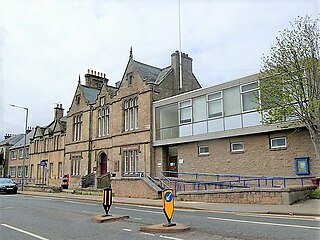
County Buildings is a municipal structure in Newtown Street, Duns, Scottish Borders, Scotland. The complex, which was the headquarters of Berwickshire County Council and was also used as a courthouse, is a Category C listed building.

County Buildings is a municipal structure in Ettrick Terrace, Selkirk, Scottish Borders, Scotland. The complex, which was the headquarters of Selkirkshire County Council and was also used as a courthouse, is a Category B listed building.


















